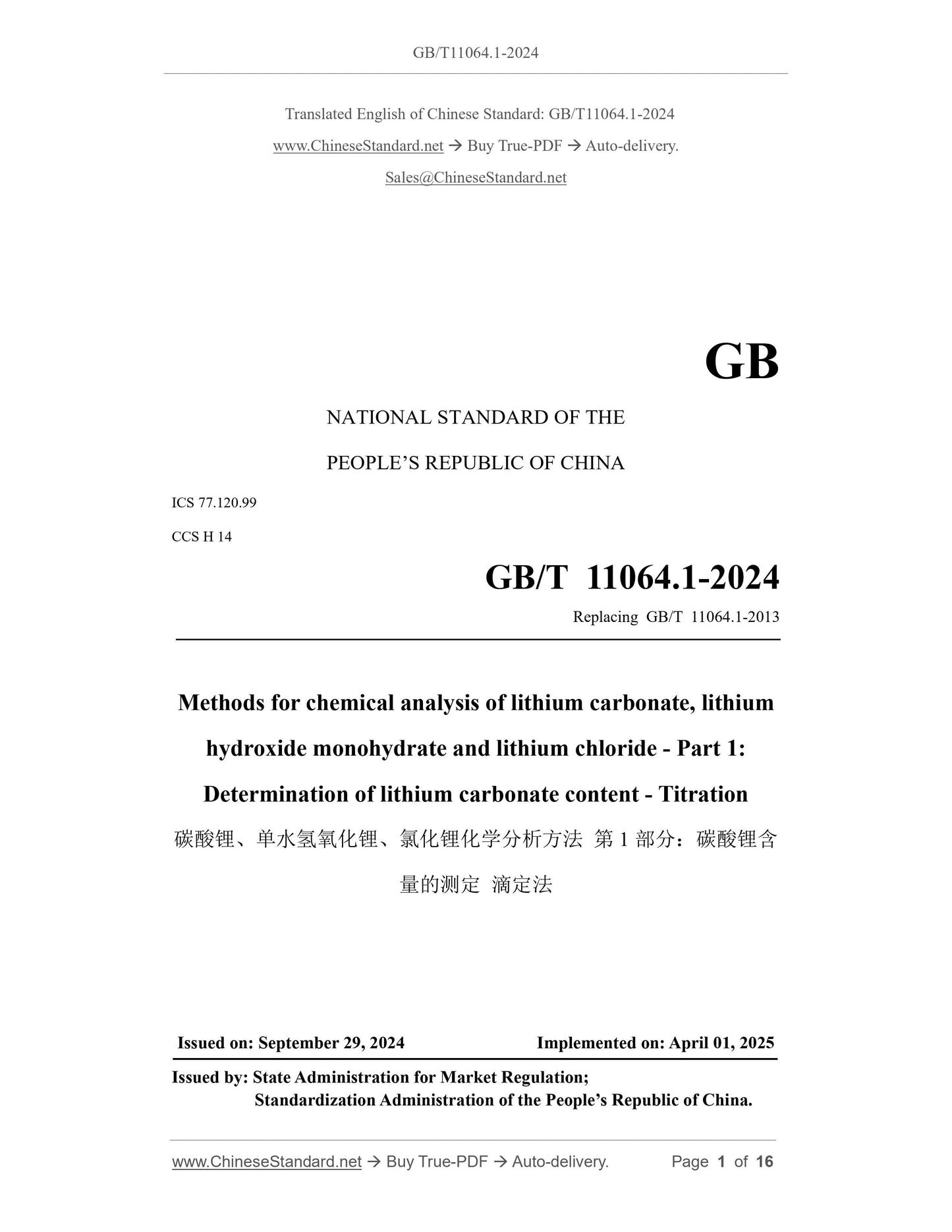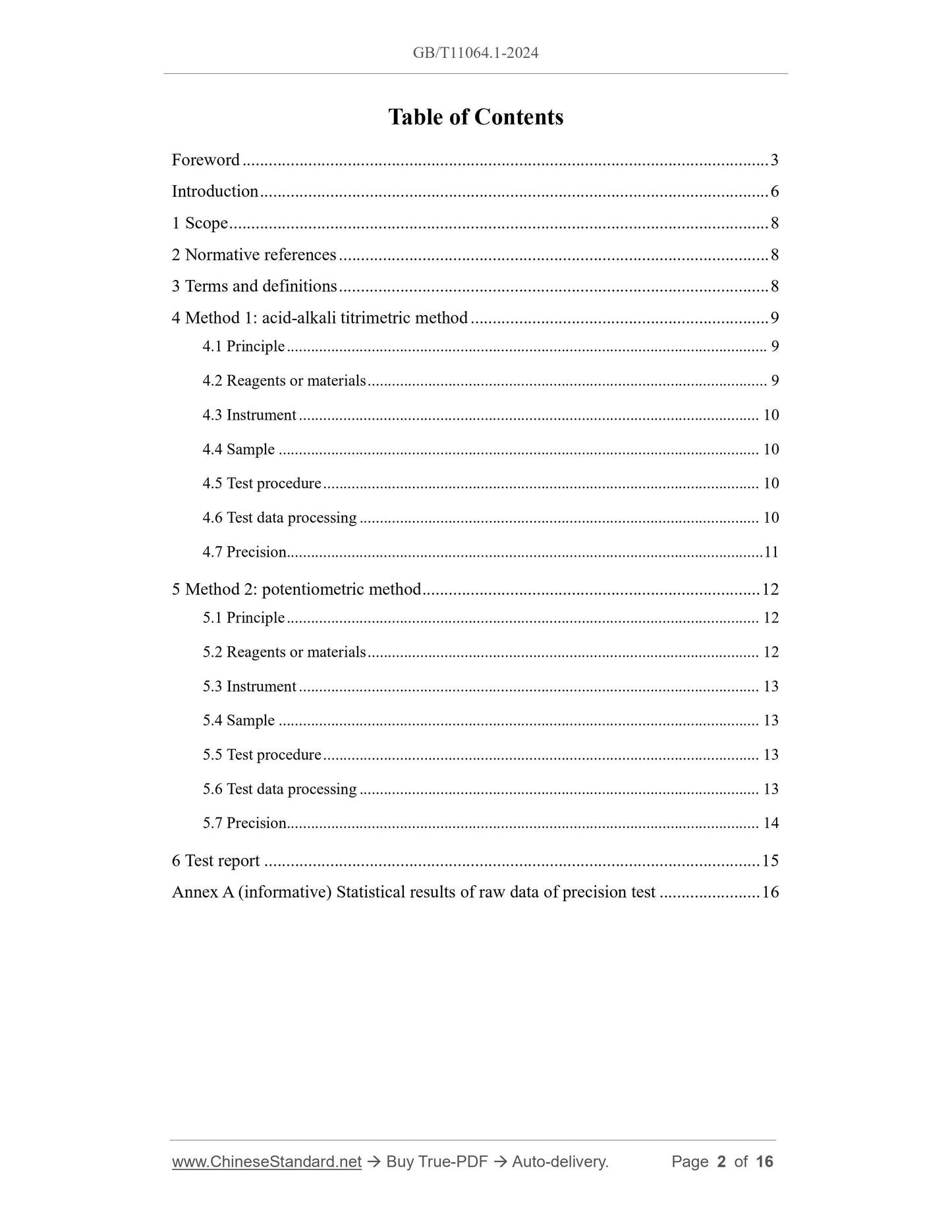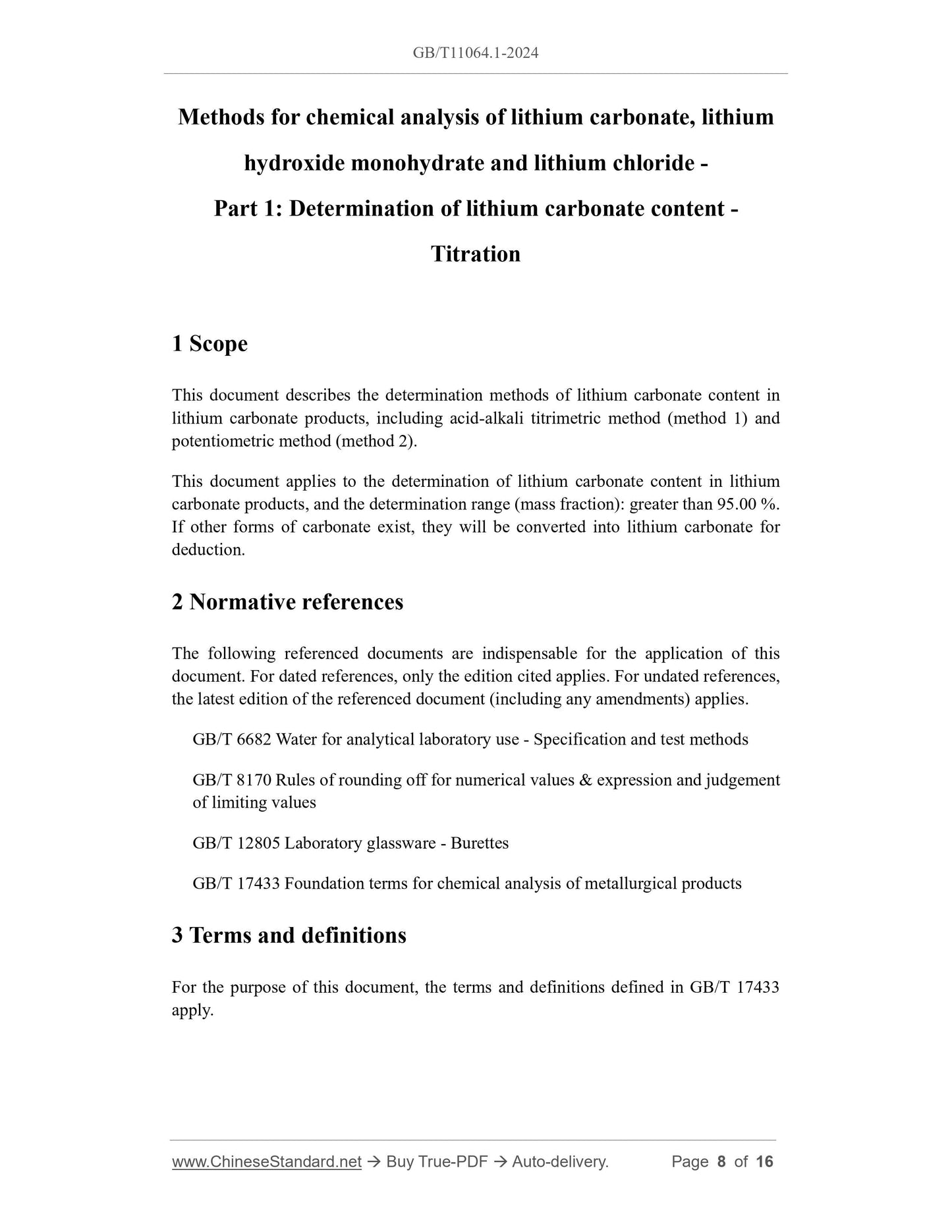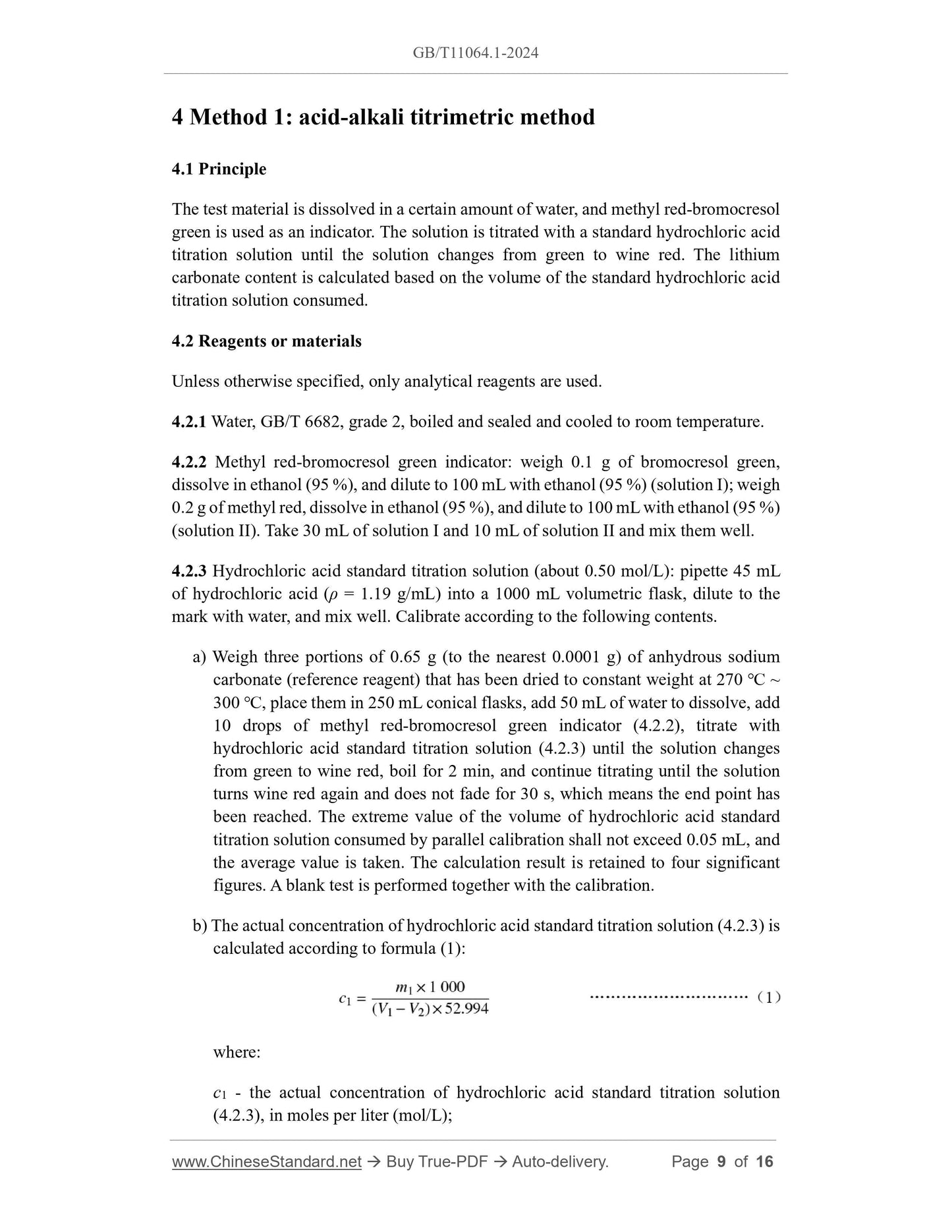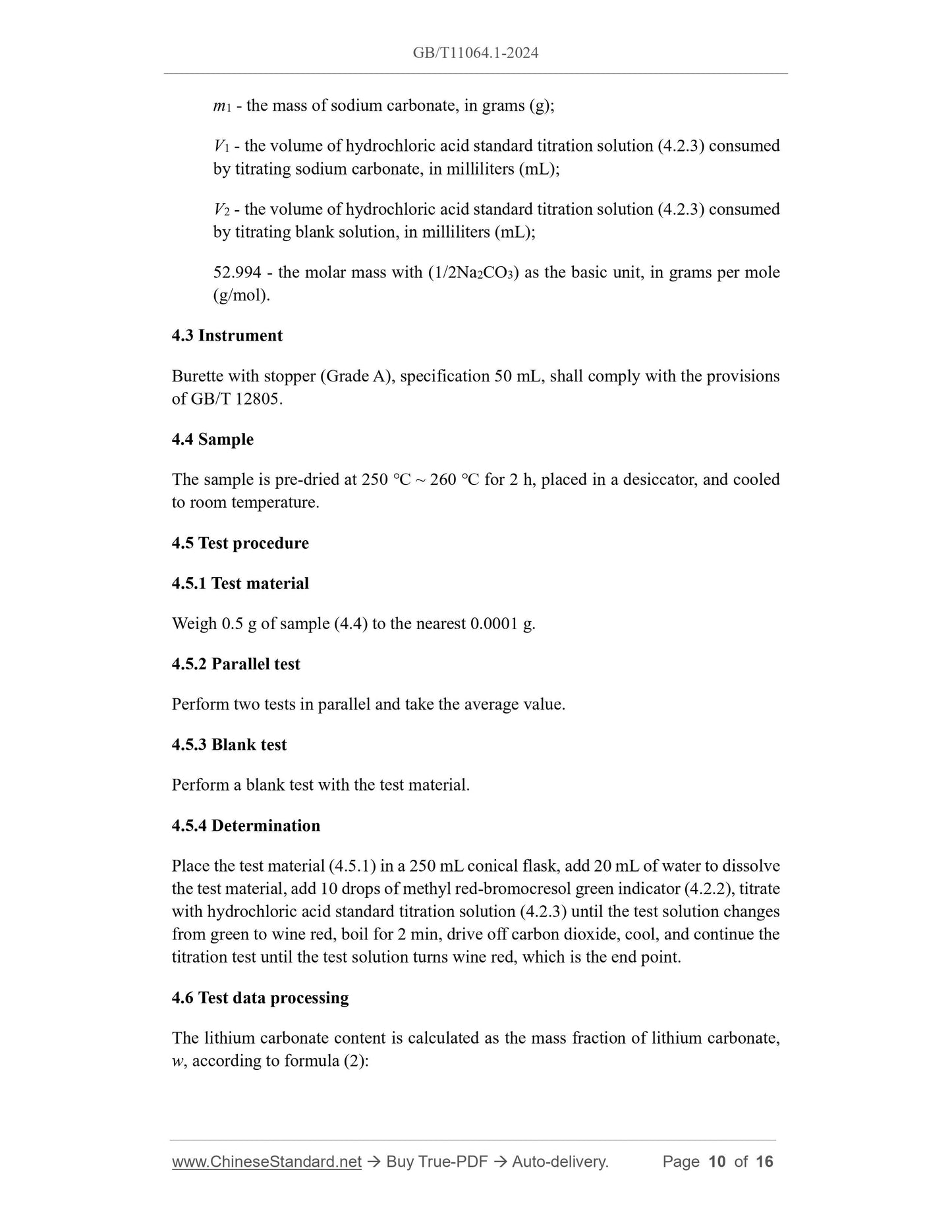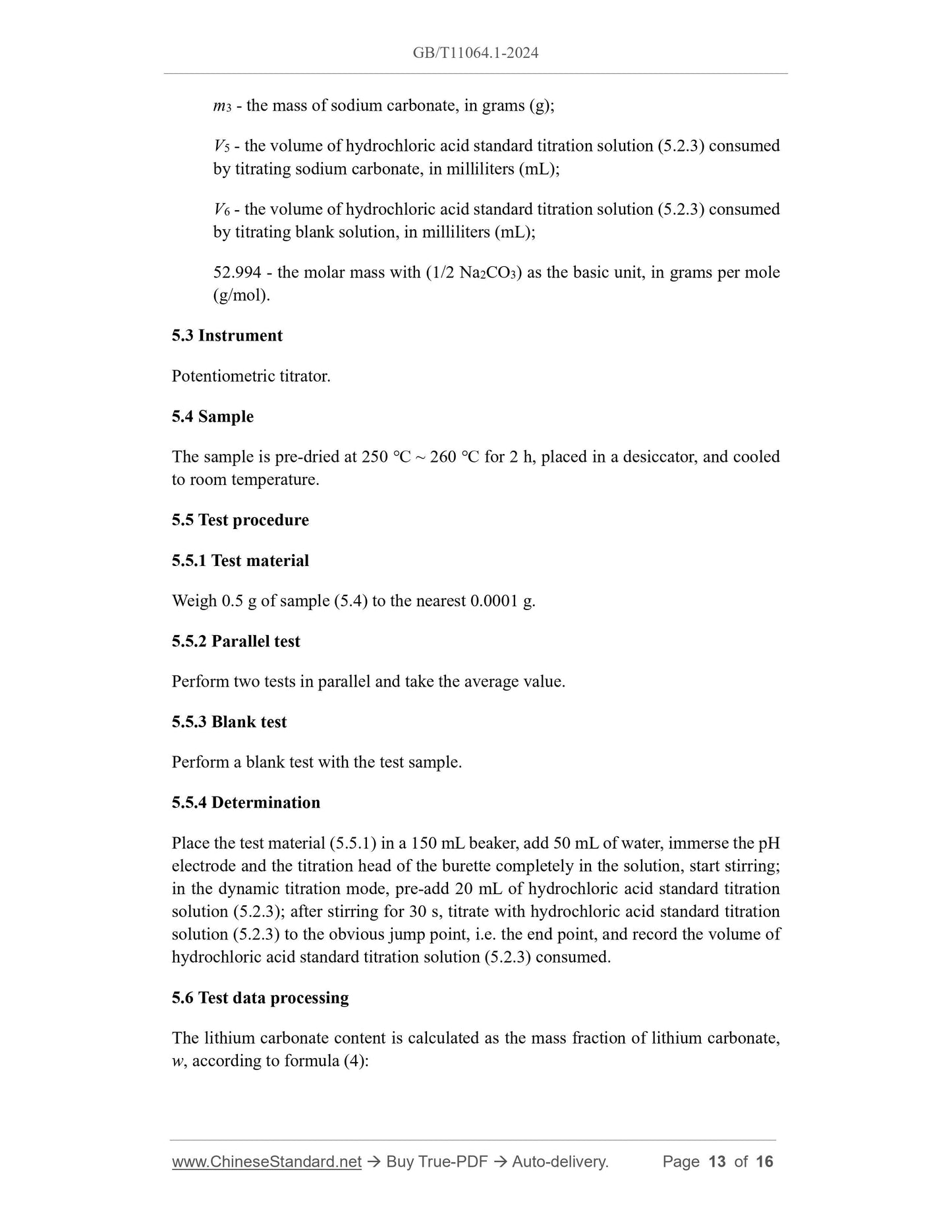1
/
of
7
www.ChineseStandard.us -- Field Test Asia Pte. Ltd.
GB/T 11064.1-2024 English PDF (GB/T11064.1-2024)
GB/T 11064.1-2024 English PDF (GB/T11064.1-2024)
Regular price
$275.00
Regular price
Sale price
$275.00
Unit price
/
per
Shipping calculated at checkout.
Couldn't load pickup availability
GB/T 11064.1-2024: Methods for chemical analysis of lithium carbonate, lithium hydroxide monohydrate and lithium chloride - Part 1: Determination of lithium carbonate content - Titration
Delivery: 9 seconds. Download (& Email) true-PDF + Invoice.
Get Quotation: Click GB/T 11064.1-2024 (Self-service in 1-minute)
Historical versions (Master-website): GB/T 11064.1-2024
Preview True-PDF (Reload/Scroll-down if blank)
GB/T 11064.1-2024
GB
NATIONAL STANDARD OF THE
PEOPLE’S REPUBLIC OF CHINA
ICS 77.120.99
CCS H 14
GB/T 11064.1-2024
Replacing GB/T 11064.1-2013
Methods for chemical analysis of lithium carbonate, lithium
hydroxide monohydrate and lithium chloride - Part 1:
Determination of lithium carbonate content - Titration
ISSUED ON: SEPTEMBER 29, 2024
IMPLEMENTED ON: APRIL 01, 2025
Issued by: State Administration for Market Regulation;
Standardization Administration of the People’s Republic of China.
Table of Contents
Foreword ... 3
Introduction ... 6
1 Scope ... 8
2 Normative references ... 8
3 Terms and definitions ... 8
4 Method 1: acid-alkali titrimetric method ... 9
4.1 Principle ... 9
4.2 Reagents or materials ... 9
4.3 Instrument ... 10
4.4 Sample ... 10
4.5 Test procedure ... 10
4.6 Test data processing ... 10
4.7 Precision ... 11
5 Method 2: potentiometric method ... 12
5.1 Principle ... 12
5.2 Reagents or materials ... 12
5.3 Instrument ... 13
5.4 Sample ... 13
5.5 Test procedure ... 13
5.6 Test data processing ... 13
5.7 Precision ... 14
6 Test report ... 15
Annex A (informative) Statistical results of raw data of precision test ... 16
Methods for chemical analysis of lithium carbonate, lithium
hydroxide monohydrate and lithium chloride -
Part 1: Determination of lithium carbonate content -
Titration
1 Scope
This document describes the determination methods of lithium carbonate content in
lithium carbonate products, including acid-alkali titrimetric method (method 1) and
potentiometric method (method 2).
This document applies to the determination of lithium carbonate content in lithium
carbonate products, and the determination range (mass fraction): greater than 95.00 %.
If other forms of carbonate exist, they will be converted into lithium carbonate for
deduction.
2 Normative references
The following referenced documents are indispensable for the application of this
document. For dated references, only the edition cited applies. For undated references,
the latest edition of the referenced document (including any amendments) applies.
GB/T 6682 Water for analytical laboratory use - Specification and test methods
GB/T 8170 Rules of rounding off for numerical values and expression and judgement
of limiting values
GB/T 12805 Laboratory glassware - Burettes
GB/T 17433 Foundation terms for chemical analysis of metallurgical products
3 Terms and definitions
For the purpose of this document, the terms and definitions defined in GB/T 17433
apply.
4 Method 1: acid-alkali titrimetric method
4.1 Principle
The test material is dissolved in a certain amount of water, and methyl red-bromocresol
green is used as an indicator. The solution is titrated with a standard hydrochloric acid
titration solution until the solution changes from green to wine red. The lithium
carbonate content is calculated based on the volume of the standard hydrochloric acid
titration solution consumed.
4.2 Reagents or materials
Unless otherwise specified, only analytical reagents are used.
4.2.1 Water, GB/T 6682, grade 2, boiled and sealed and cooled to room temperature.
4.2.2 Methyl red-bromocresol green indicator: weigh 0.1 g of bromocresol green,
dissolve in ethanol (95 %), and dilute to 100 mL with ethanol (95 %) (solution I); weigh
0.2 g of methyl red, dissolve in ethanol (95 %), and dilute to 100 mL with ethanol (95 %)
(solution II). Take 30 mL of solution I and 10 mL of solution II and mix them well.
4.2.3 Hydrochloric acid standard titration solution (about 0.50 mol/L): pipette 45 mL
of hydrochloric acid (ρ = 1.19 g/mL) into a 1000 mL volumetric flask, dilute to the
mark with water, and mix well. Calibrate according to the following contents.
a) Weigh three portions of 0.65 g (to the nearest 0.0001 g) of anhydrous sodium
carbonate (reference reagent) that has been dried to constant weight at 270 ℃ ~
300 ℃, place them in 250 mL conical flasks, add 50 mL of water to dissolve, add
10 drops of methyl red-bromocresol green indicator (4.2.2), titrate with
hydrochloric acid standard titration solution (4.2.3) until the solution changes
from green to wine red, boil for 2 min, and continue titrating until the solution
turns wine red again and does not fade for 30 s, which means the end point has
been reached. The extreme value of the volume of hydrochloric acid standard
titration solution consumed by parallel calibration shall not exceed 0.05 mL, and
the average value is taken. The calculation result is retained to four significant
figures. A blank test is performed together with the calibration.
b) The actual concentration of hydrochloric acid standard titration solution (4.2.3) is
calculated according to formula (1):
where:
c1 - the actual concentration of hydrochloric acid standard titration solution
(4.2.3), in moles per liter (mol/L);
m1 - the mass of sodium carbonate, in grams (g);
V1 - the volume of hydrochloric acid standard titration solution (4.2.3) consumed
by titrating sodium carbonate, in milliliters (mL);
V2 - the volume of hydrochloric acid standard titration solution (4.2.3) consumed
by titrating blank solution, in milliliters (mL);
52.994 - the molar mass with (1/2Na2CO3) as the basic unit, in grams per mole
(g/mol).
4.3 Instrument
Burette with stopper (Grade A), specification 50 mL, shall comply with the provisions
of GB/T 12805.
4.4 Sample
The sample is pre-dried at 250 ℃ ~ 260 ℃ for 2 h, placed in a desiccator, and cooled
to room temperature.
4.5 Test procedure
4.5.1 Test material
Weigh 0.5 g of sample (4.4) to the nearest 0.0001 g.
4.5.2 Parallel test
Perform two tests in parallel and take the average value.
4.5.3 Blank test
Perform a blank test with the test material.
4.5.4 Determination
Place the test material (4.5.1) in a 250 mL conical flask, add 20 mL of water to dissolve
the test material, add 10 drops of methyl red-bromocresol green indicator (4.2.2), titrate
with hydrochloric acid standard titration solution (4.2.3) until the test solution changes
from green to wine red, boil for 2 min, drive off carbon dioxide, cool, and continue the
titration test until the test solution turns wine red, which is the end point.
4.6 Test data processing
The lithium carbonate content is calculated as the mass fraction of lithium carbonate,
w, according to formula (2):
5 Method 2: potentiometric method
5.1 Principle
The test material is dissolved in a certain amount of water and titrated using a
potentiometric titrator, with a pH glass composite electrode as the working electrode
and a hydrochloric acid standard titration solution as the titrant. The reaction endpoint
is determined by the jump point of the indicator electrode potential, and the lithium
carbonate content is calculated based on the volume of hydrochloric acid standard
titration solution consumed.
5.2 Reagents or materials
Unless otherwise specified, only analytical reagents shall be used.
5.2.1 Water, GB/T 6682, grade 2, boiled and sealed and cooled to room temperature.
5.2.2 Methyl red-bromocresol green indicator: weigh 0.1 g of bromocresol green,
dissolve in ethanol (95 %), and dilute to 100 mL with ethanol (95 %) (solution I); weigh
0.2 g of methyl red, dissolve in ethanol (95 %), and dilute to 100 mL with ethanol (95 %)
(solution II). Take 30 mL of solution I and 10 mL of solution II and mix well.
5.2.3 Hydrochloric acid standard titration solution (about 0.50 mol/L): transfer 45 mL
of hydrochloric acid (ρ = 1.19 g/mL) to a 1000 mL volumetric flask, dilute to the mark
with water, and mix well. Calibrate according to the following content.
a) Weigh three portions of 0.65 g (to the nearest 0.0001 g) of anhydrous sodium
carbonate (reference reagent) that has been dried to a constant amount at 270 ℃
~ 300 ℃, place them in 150 mL beakers respectively, add 50 mL of water to
dissolve, use the pH electrode as the measuring electrode, and titrate to the
endpoint with hydrochloric acid standard titration solution (5.2.3) in the dynamic
titration mode according to the sample analysis procedure (5.5.4). The extreme
value of the volume of hydrochloric acid standard titration solution consumed in
parallel calibration shall not exceed 0.05 mL, and the average value is taken. The
calculation result retains four significant digits. Perform a blank test together with
the calibration.
b) The actual concentration of hydrochloric acid standard titration solution (5.2.3) is
calculated according to formula (3):
where:
c2 - the actual concentration of hydrochloric acid standard titration solution
(5.2.3), in moles per liter (mol/L);
m3 - the mass of sodium carbonate, in grams (g);
V5 - the volume of hydrochloric acid standard titration solution (5.2.3) consumed
by titrating sodium carbonate, in milliliters (mL);
V6 - the volume of hydrochloric acid standard titration solution (5.2.3) consumed
by titrating blank solution, in milliliters (mL);
52.994 - the molar mass with (1/2 Na2CO3) as the basic unit, in grams per mole
(g/mol).
5.3 Instrument
Potentiometric titrator.
5.4 Sample
The sample is pre-dried at 250 ℃ ~ 260 ℃ for 2 h, placed in a desiccator, and cooled
to room temperature.
5.5 Test procedure
5.5.1 Test material
Weigh 0.5 g of sample (5.4) to the nearest 0.0001 g.
5.5.2 Parallel test
Perform two tests in parallel and take the average value.
5.5.3 Blank test
Perform a blank test with the test sample.
5.5.4 Determination
Place the test material (5.5.1) in a 150 mL beaker, add 50 mL of water, immerse the pH
electrode and the titration head of the burette completely in the solution, start stirring;
in the dynamic titration mode, pre-add 20 mL of hydrochloric acid standard titration
solution (5.2.3); after stirring for 30 s, titrate with hydrochloric acid standard titration
solution (5.2.3) to the obvious jump point, i.e. the end point, and record the volume of
hydrochloric acid standard titration solution (5.2.3) consumed.
5.6 Test data processing
The lithium carbonate content is calculated as the mass fraction of lithium carbonate,
w, according to formula (4):
GB/T 11064.1-2024
GB
NATIONAL STANDARD OF THE
PEOPLE’S REPUBLIC OF CHINA
ICS 77.120.99
CCS H 14
GB/T 11064.1-2024
Replacing GB/T 11064.1-2013
Methods for chemical analysis of lithium carbonate, lithium
hydroxide monohydrate and lithium chloride - Part 1:
Determination of lithium carbonate content - Titration
ISSUED ON: SEPTEMBER 29, 2024
IMPLEMENTED ON: APRIL 01, 2025
Issued by: State Administration for Market Regulation;
Standardization Administration of the People’s Republic of China.
Table of Contents
Foreword ... 3
Introduction ... 6
1 Scope ... 8
2 Normative references ... 8
3 Terms and definitions ... 8
4 Method 1: acid-alkali titrimetric method ... 9
4.1 Principle ... 9
4.2 Reagents or materials ... 9
4.3 Instrument ... 10
4.4 Sample ... 10
4.5 Test procedure ... 10
4.6 Test data processing ... 10
4.7 Precision ... 11
5 Method 2: potentiometric method ... 12
5.1 Principle ... 12
5.2 Reagents or materials ... 12
5.3 Instrument ... 13
5.4 Sample ... 13
5.5 Test procedure ... 13
5.6 Test data processing ... 13
5.7 Precision ... 14
6 Test report ... 15
Annex A (informative) Statistical results of raw data of precision test ... 16
Methods for chemical analysis of lithium carbonate, lithium
hydroxide monohydrate and lithium chloride -
Part 1: Determination of lithium carbonate content -
Titration
1 Scope
This document describes the determination methods of lithium carbonate content in
lithium carbonate products, including acid-alkali titrimetric method (method 1) and
potentiometric method (method 2).
This document applies to the determination of lithium carbonate content in lithium
carbonate products, and the determination range (mass fraction): greater than 95.00 %.
If other forms of carbonate exist, they will be converted into lithium carbonate for
deduction.
2 Normative references
The following referenced documents are indispensable for the application of this
document. For dated references, only the edition cited applies. For undated references,
the latest edition of the referenced document (including any amendments) applies.
GB/T 6682 Water for analytical laboratory use - Specification and test methods
GB/T 8170 Rules of rounding off for numerical values and expression and judgement
of limiting values
GB/T 12805 Laboratory glassware - Burettes
GB/T 17433 Foundation terms for chemical analysis of metallurgical products
3 Terms and definitions
For the purpose of this document, the terms and definitions defined in GB/T 17433
apply.
4 Method 1: acid-alkali titrimetric method
4.1 Principle
The test material is dissolved in a certain amount of water, and methyl red-bromocresol
green is used as an indicator. The solution is titrated with a standard hydrochloric acid
titration solution until the solution changes from green to wine red. The lithium
carbonate content is calculated based on the volume of the standard hydrochloric acid
titration solution consumed.
4.2 Reagents or materials
Unless otherwise specified, only analytical reagents are used.
4.2.1 Water, GB/T 6682, grade 2, boiled and sealed and cooled to room temperature.
4.2.2 Methyl red-bromocresol green indicator: weigh 0.1 g of bromocresol green,
dissolve in ethanol (95 %), and dilute to 100 mL with ethanol (95 %) (solution I); weigh
0.2 g of methyl red, dissolve in ethanol (95 %), and dilute to 100 mL with ethanol (95 %)
(solution II). Take 30 mL of solution I and 10 mL of solution II and mix them well.
4.2.3 Hydrochloric acid standard titration solution (about 0.50 mol/L): pipette 45 mL
of hydrochloric acid (ρ = 1.19 g/mL) into a 1000 mL volumetric flask, dilute to the
mark with water, and mix well. Calibrate according to the following contents.
a) Weigh three portions of 0....
Delivery: 9 seconds. Download (& Email) true-PDF + Invoice.
Get Quotation: Click GB/T 11064.1-2024 (Self-service in 1-minute)
Historical versions (Master-website): GB/T 11064.1-2024
Preview True-PDF (Reload/Scroll-down if blank)
GB/T 11064.1-2024
GB
NATIONAL STANDARD OF THE
PEOPLE’S REPUBLIC OF CHINA
ICS 77.120.99
CCS H 14
GB/T 11064.1-2024
Replacing GB/T 11064.1-2013
Methods for chemical analysis of lithium carbonate, lithium
hydroxide monohydrate and lithium chloride - Part 1:
Determination of lithium carbonate content - Titration
ISSUED ON: SEPTEMBER 29, 2024
IMPLEMENTED ON: APRIL 01, 2025
Issued by: State Administration for Market Regulation;
Standardization Administration of the People’s Republic of China.
Table of Contents
Foreword ... 3
Introduction ... 6
1 Scope ... 8
2 Normative references ... 8
3 Terms and definitions ... 8
4 Method 1: acid-alkali titrimetric method ... 9
4.1 Principle ... 9
4.2 Reagents or materials ... 9
4.3 Instrument ... 10
4.4 Sample ... 10
4.5 Test procedure ... 10
4.6 Test data processing ... 10
4.7 Precision ... 11
5 Method 2: potentiometric method ... 12
5.1 Principle ... 12
5.2 Reagents or materials ... 12
5.3 Instrument ... 13
5.4 Sample ... 13
5.5 Test procedure ... 13
5.6 Test data processing ... 13
5.7 Precision ... 14
6 Test report ... 15
Annex A (informative) Statistical results of raw data of precision test ... 16
Methods for chemical analysis of lithium carbonate, lithium
hydroxide monohydrate and lithium chloride -
Part 1: Determination of lithium carbonate content -
Titration
1 Scope
This document describes the determination methods of lithium carbonate content in
lithium carbonate products, including acid-alkali titrimetric method (method 1) and
potentiometric method (method 2).
This document applies to the determination of lithium carbonate content in lithium
carbonate products, and the determination range (mass fraction): greater than 95.00 %.
If other forms of carbonate exist, they will be converted into lithium carbonate for
deduction.
2 Normative references
The following referenced documents are indispensable for the application of this
document. For dated references, only the edition cited applies. For undated references,
the latest edition of the referenced document (including any amendments) applies.
GB/T 6682 Water for analytical laboratory use - Specification and test methods
GB/T 8170 Rules of rounding off for numerical values and expression and judgement
of limiting values
GB/T 12805 Laboratory glassware - Burettes
GB/T 17433 Foundation terms for chemical analysis of metallurgical products
3 Terms and definitions
For the purpose of this document, the terms and definitions defined in GB/T 17433
apply.
4 Method 1: acid-alkali titrimetric method
4.1 Principle
The test material is dissolved in a certain amount of water, and methyl red-bromocresol
green is used as an indicator. The solution is titrated with a standard hydrochloric acid
titration solution until the solution changes from green to wine red. The lithium
carbonate content is calculated based on the volume of the standard hydrochloric acid
titration solution consumed.
4.2 Reagents or materials
Unless otherwise specified, only analytical reagents are used.
4.2.1 Water, GB/T 6682, grade 2, boiled and sealed and cooled to room temperature.
4.2.2 Methyl red-bromocresol green indicator: weigh 0.1 g of bromocresol green,
dissolve in ethanol (95 %), and dilute to 100 mL with ethanol (95 %) (solution I); weigh
0.2 g of methyl red, dissolve in ethanol (95 %), and dilute to 100 mL with ethanol (95 %)
(solution II). Take 30 mL of solution I and 10 mL of solution II and mix them well.
4.2.3 Hydrochloric acid standard titration solution (about 0.50 mol/L): pipette 45 mL
of hydrochloric acid (ρ = 1.19 g/mL) into a 1000 mL volumetric flask, dilute to the
mark with water, and mix well. Calibrate according to the following contents.
a) Weigh three portions of 0.65 g (to the nearest 0.0001 g) of anhydrous sodium
carbonate (reference reagent) that has been dried to constant weight at 270 ℃ ~
300 ℃, place them in 250 mL conical flasks, add 50 mL of water to dissolve, add
10 drops of methyl red-bromocresol green indicator (4.2.2), titrate with
hydrochloric acid standard titration solution (4.2.3) until the solution changes
from green to wine red, boil for 2 min, and continue titrating until the solution
turns wine red again and does not fade for 30 s, which means the end point has
been reached. The extreme value of the volume of hydrochloric acid standard
titration solution consumed by parallel calibration shall not exceed 0.05 mL, and
the average value is taken. The calculation result is retained to four significant
figures. A blank test is performed together with the calibration.
b) The actual concentration of hydrochloric acid standard titration solution (4.2.3) is
calculated according to formula (1):
where:
c1 - the actual concentration of hydrochloric acid standard titration solution
(4.2.3), in moles per liter (mol/L);
m1 - the mass of sodium carbonate, in grams (g);
V1 - the volume of hydrochloric acid standard titration solution (4.2.3) consumed
by titrating sodium carbonate, in milliliters (mL);
V2 - the volume of hydrochloric acid standard titration solution (4.2.3) consumed
by titrating blank solution, in milliliters (mL);
52.994 - the molar mass with (1/2Na2CO3) as the basic unit, in grams per mole
(g/mol).
4.3 Instrument
Burette with stopper (Grade A), specification 50 mL, shall comply with the provisions
of GB/T 12805.
4.4 Sample
The sample is pre-dried at 250 ℃ ~ 260 ℃ for 2 h, placed in a desiccator, and cooled
to room temperature.
4.5 Test procedure
4.5.1 Test material
Weigh 0.5 g of sample (4.4) to the nearest 0.0001 g.
4.5.2 Parallel test
Perform two tests in parallel and take the average value.
4.5.3 Blank test
Perform a blank test with the test material.
4.5.4 Determination
Place the test material (4.5.1) in a 250 mL conical flask, add 20 mL of water to dissolve
the test material, add 10 drops of methyl red-bromocresol green indicator (4.2.2), titrate
with hydrochloric acid standard titration solution (4.2.3) until the test solution changes
from green to wine red, boil for 2 min, drive off carbon dioxide, cool, and continue the
titration test until the test solution turns wine red, which is the end point.
4.6 Test data processing
The lithium carbonate content is calculated as the mass fraction of lithium carbonate,
w, according to formula (2):
5 Method 2: potentiometric method
5.1 Principle
The test material is dissolved in a certain amount of water and titrated using a
potentiometric titrator, with a pH glass composite electrode as the working electrode
and a hydrochloric acid standard titration solution as the titrant. The reaction endpoint
is determined by the jump point of the indicator electrode potential, and the lithium
carbonate content is calculated based on the volume of hydrochloric acid standard
titration solution consumed.
5.2 Reagents or materials
Unless otherwise specified, only analytical reagents shall be used.
5.2.1 Water, GB/T 6682, grade 2, boiled and sealed and cooled to room temperature.
5.2.2 Methyl red-bromocresol green indicator: weigh 0.1 g of bromocresol green,
dissolve in ethanol (95 %), and dilute to 100 mL with ethanol (95 %) (solution I); weigh
0.2 g of methyl red, dissolve in ethanol (95 %), and dilute to 100 mL with ethanol (95 %)
(solution II). Take 30 mL of solution I and 10 mL of solution II and mix well.
5.2.3 Hydrochloric acid standard titration solution (about 0.50 mol/L): transfer 45 mL
of hydrochloric acid (ρ = 1.19 g/mL) to a 1000 mL volumetric flask, dilute to the mark
with water, and mix well. Calibrate according to the following content.
a) Weigh three portions of 0.65 g (to the nearest 0.0001 g) of anhydrous sodium
carbonate (reference reagent) that has been dried to a constant amount at 270 ℃
~ 300 ℃, place them in 150 mL beakers respectively, add 50 mL of water to
dissolve, use the pH electrode as the measuring electrode, and titrate to the
endpoint with hydrochloric acid standard titration solution (5.2.3) in the dynamic
titration mode according to the sample analysis procedure (5.5.4). The extreme
value of the volume of hydrochloric acid standard titration solution consumed in
parallel calibration shall not exceed 0.05 mL, and the average value is taken. The
calculation result retains four significant digits. Perform a blank test together with
the calibration.
b) The actual concentration of hydrochloric acid standard titration solution (5.2.3) is
calculated according to formula (3):
where:
c2 - the actual concentration of hydrochloric acid standard titration solution
(5.2.3), in moles per liter (mol/L);
m3 - the mass of sodium carbonate, in grams (g);
V5 - the volume of hydrochloric acid standard titration solution (5.2.3) consumed
by titrating sodium carbonate, in milliliters (mL);
V6 - the volume of hydrochloric acid standard titration solution (5.2.3) consumed
by titrating blank solution, in milliliters (mL);
52.994 - the molar mass with (1/2 Na2CO3) as the basic unit, in grams per mole
(g/mol).
5.3 Instrument
Potentiometric titrator.
5.4 Sample
The sample is pre-dried at 250 ℃ ~ 260 ℃ for 2 h, placed in a desiccator, and cooled
to room temperature.
5.5 Test procedure
5.5.1 Test material
Weigh 0.5 g of sample (5.4) to the nearest 0.0001 g.
5.5.2 Parallel test
Perform two tests in parallel and take the average value.
5.5.3 Blank test
Perform a blank test with the test sample.
5.5.4 Determination
Place the test material (5.5.1) in a 150 mL beaker, add 50 mL of water, immerse the pH
electrode and the titration head of the burette completely in the solution, start stirring;
in the dynamic titration mode, pre-add 20 mL of hydrochloric acid standard titration
solution (5.2.3); after stirring for 30 s, titrate with hydrochloric acid standard titration
solution (5.2.3) to the obvious jump point, i.e. the end point, and record the volume of
hydrochloric acid standard titration solution (5.2.3) consumed.
5.6 Test data processing
The lithium carbonate content is calculated as the mass fraction of lithium carbonate,
w, according to formula (4):
GB/T 11064.1-2024
GB
NATIONAL STANDARD OF THE
PEOPLE’S REPUBLIC OF CHINA
ICS 77.120.99
CCS H 14
GB/T 11064.1-2024
Replacing GB/T 11064.1-2013
Methods for chemical analysis of lithium carbonate, lithium
hydroxide monohydrate and lithium chloride - Part 1:
Determination of lithium carbonate content - Titration
ISSUED ON: SEPTEMBER 29, 2024
IMPLEMENTED ON: APRIL 01, 2025
Issued by: State Administration for Market Regulation;
Standardization Administration of the People’s Republic of China.
Table of Contents
Foreword ... 3
Introduction ... 6
1 Scope ... 8
2 Normative references ... 8
3 Terms and definitions ... 8
4 Method 1: acid-alkali titrimetric method ... 9
4.1 Principle ... 9
4.2 Reagents or materials ... 9
4.3 Instrument ... 10
4.4 Sample ... 10
4.5 Test procedure ... 10
4.6 Test data processing ... 10
4.7 Precision ... 11
5 Method 2: potentiometric method ... 12
5.1 Principle ... 12
5.2 Reagents or materials ... 12
5.3 Instrument ... 13
5.4 Sample ... 13
5.5 Test procedure ... 13
5.6 Test data processing ... 13
5.7 Precision ... 14
6 Test report ... 15
Annex A (informative) Statistical results of raw data of precision test ... 16
Methods for chemical analysis of lithium carbonate, lithium
hydroxide monohydrate and lithium chloride -
Part 1: Determination of lithium carbonate content -
Titration
1 Scope
This document describes the determination methods of lithium carbonate content in
lithium carbonate products, including acid-alkali titrimetric method (method 1) and
potentiometric method (method 2).
This document applies to the determination of lithium carbonate content in lithium
carbonate products, and the determination range (mass fraction): greater than 95.00 %.
If other forms of carbonate exist, they will be converted into lithium carbonate for
deduction.
2 Normative references
The following referenced documents are indispensable for the application of this
document. For dated references, only the edition cited applies. For undated references,
the latest edition of the referenced document (including any amendments) applies.
GB/T 6682 Water for analytical laboratory use - Specification and test methods
GB/T 8170 Rules of rounding off for numerical values and expression and judgement
of limiting values
GB/T 12805 Laboratory glassware - Burettes
GB/T 17433 Foundation terms for chemical analysis of metallurgical products
3 Terms and definitions
For the purpose of this document, the terms and definitions defined in GB/T 17433
apply.
4 Method 1: acid-alkali titrimetric method
4.1 Principle
The test material is dissolved in a certain amount of water, and methyl red-bromocresol
green is used as an indicator. The solution is titrated with a standard hydrochloric acid
titration solution until the solution changes from green to wine red. The lithium
carbonate content is calculated based on the volume of the standard hydrochloric acid
titration solution consumed.
4.2 Reagents or materials
Unless otherwise specified, only analytical reagents are used.
4.2.1 Water, GB/T 6682, grade 2, boiled and sealed and cooled to room temperature.
4.2.2 Methyl red-bromocresol green indicator: weigh 0.1 g of bromocresol green,
dissolve in ethanol (95 %), and dilute to 100 mL with ethanol (95 %) (solution I); weigh
0.2 g of methyl red, dissolve in ethanol (95 %), and dilute to 100 mL with ethanol (95 %)
(solution II). Take 30 mL of solution I and 10 mL of solution II and mix them well.
4.2.3 Hydrochloric acid standard titration solution (about 0.50 mol/L): pipette 45 mL
of hydrochloric acid (ρ = 1.19 g/mL) into a 1000 mL volumetric flask, dilute to the
mark with water, and mix well. Calibrate according to the following contents.
a) Weigh three portions of 0....
Share
